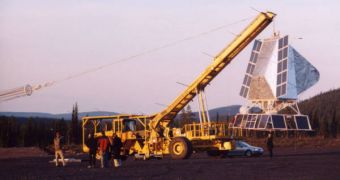Yesterday's (April 8th) issue of the scientific journal Nature has seen the publication of a paper that crowns more than two years of research on the origins of starlight, the faint glow of the Universe, whose source has remained a mystery until only recently.
Experts from the University of Toronto and the University of British Columbia were behind the investigation, which analyzed data provided by the Balloon-borne Large-Aperture Sub-millimeter Telescope (BLAST) project. The scientists learned that nearly half of all starlight in the Universe came from very young, star-forming galaxies, several billions of light-years away from our position.
“While those familiar optical images of the night sky contain many fascinating and beautiful objects, they are missing half of the picture in describing the cosmic history of star formation,” Douglas Scott, a professor of astronomy at UBC, said.
“Stars are born in clouds of gas and dust. The dust absorbs the starlight, hiding the young stars from view. The brightest stars in the Universe are also the shortest lived and many never leave their stellar nursery. However, the warmed dust emits light at far-infrared and submillimeter wavelengths – invisible to the human eye, but visible to the sensitive thermo-detectors on BLAST,” UT Department of Astronomy & Astrophysics Cosmologist Barth Netterfield added.
In addition to the BLAST data, which was in the 0.3-millimeter wavelength – between microwave and infrared – the science team also used readings from NASA's Spitzer Space Telescope, which operates in the infrared wavelength. The BLAST instrument itself, weighing more than 2 tonnes, was lifted in the upper atmosphere by a 33-story-high balloon, in an aluminum gondola constructed especially for this project. The telescope had a 2.2-meter-wide main mirror, the largest in its category.
“Over the last decade, submillimeter telescopes on the ground have produced several 'black and white' images no larger than the size of a fingernail at the end of your outstretched arm. In a single 11-day flight, BLAST has taken a huge leap forward, producing color images the size of your hand,” UBC post-doctoral fellow Ed Chapin, who was also involved in the study, shared.
“BLAST has given us a new view of the Universe. The data we collected enable us to make discoveries in topics ranging from the formation of stars to the evolution of distant galaxies,” Netterfield explained. “Over the last nine years, I've followed BLAST from Vancouver to Toronto, Philadelphia, New Mexico, Texas, northern Sweden and Antarctica, and it feels great for us to finally announce the results. These results are a very big step forward in submillimeter astronomy,” Gaelen Marsden, also a post-doctoral fellow at UBC, concluded.

 14 DAY TRIAL //
14 DAY TRIAL //